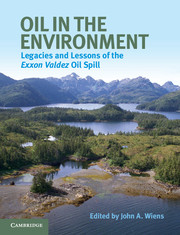Part III - Biological effects
Published online by Cambridge University Press: 05 July 2013
Summary
Introduction
As oil spreads through the marine environment and undergoes the changes described in Part II, concerns are raised by the general public, scientists, and regulators about possible effects on biological resources. These concerns may be most obvious when they relate to important subsistence and commercially valuable resources such as salmon or herring, but they extend as well to a variety of wildlife. In the days and weeks following an oil spill, speculations and hyperbole abound. Documenting whether there are actual effects, how long they last, and whether the effects are due to the oil spill or something else requires rigorous science. The chapters in this section describe how science was brought to bear on assessing potential injury to natural resources and what was learned in the process, both about the effects of the Exxon Valdez spill and about the challenges of conducting scientific investigations in a harsh and variable environment with much at stake.
We begin with two chapters that provide essential background on several analytical and design issues that reappear in subsequent chapters. In Chapter 9, James Oris and Aaron Roberts provide a cautionary review of the use of biomarkers – biochemical and molecular responses of organisms to chemicals and other stressors in the environment – as indicators of exposure. They focus on cytochrome P450 1A (CYP1A), which was used to assay exposure of several species to aromatic hydrocarbons from fossil fuels following the Exxon Valdez spill. Because CYP1A can be mobilized in response to a wide array of hydrocarbons, elevated concentrations do not provide unambiguous evidence of exposure to a specific hydrocarbon source, nor do they link exposure to potential injuries, so they must be interpreted with care.
- Type
- Chapter
- Information
- Oil in the EnvironmentLegacies and Lessons of the Exxon Valdez Oil Spill, pp. 198 - 200Publisher: Cambridge University PressPrint publication year: 2013



